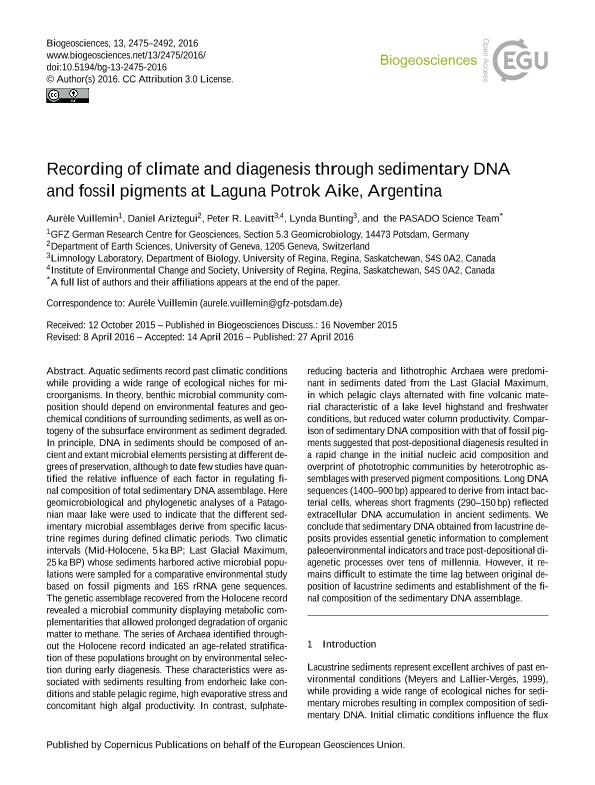Mostrar el registro sencillo del ítem
dc.contributor.author
Vuillemin, Aurèle
dc.contributor.author
Ariztegui, Daniel

dc.contributor.author
Leavitt, Peter R.
dc.contributor.author
Bunting, Lynda
dc.contributor.author
Anselmetti, Flavio
dc.contributor.author
Ariztegui, Daniel

dc.contributor.author
Corbella, Jorge Hugo

dc.contributor.author
Francus, Pierre
dc.contributor.author
Lücke, Andreas

dc.contributor.author
Maidana, Nora Irene

dc.contributor.author
Ohlendorf, Christian

dc.contributor.author
Schäbitz, Frank

dc.contributor.author
Wastegård, Stefan
dc.contributor.author
Zolitschka, Bernd

dc.date.available
2018-09-24T18:46:11Z
dc.date.issued
2016-04
dc.identifier.citation
Vuillemin, Aurèle; Ariztegui, Daniel; Leavitt, Peter R.; Bunting, Lynda; Anselmetti, Flavio; et al.; Recording of climate and diagenesis through sedimentary DNA and fossil pigments at Laguna Potrok Aike, Argentina; Copernicus Publications; Biogeosciences; 13; 8; 4-2016; 2475-2492
dc.identifier.issn
1726-4189
dc.identifier.uri
http://hdl.handle.net/11336/60787
dc.description.abstract
Aquatic sediments record past climatic conditions while providing a wide range of ecological niches for microorganisms. In theory, benthic microbial community composition should depend on environmental features and geochemical conditions of surrounding sediments, as well as ontogeny of the subsurface environment as sediment degraded. In principle, DNA in sediments should be composed of ancient and extant microbial elements persisting at different degrees of preservation, although to date few studies have quantified the relative influence of each factor in regulating final composition of total sedimentary DNA assemblage. Here geomicrobiological and phylogenetic analyses of a Patagonian maar lake were used to indicate that the different sedimentary microbial assemblages derive from specific lacustrine regimes during defined climatic periods. Two climatic intervals (Mid-Holocene, 5 ka BP; Last Glacial Maximum, 25 ka BP) whose sediments harbored active microbial populations were sampled for a comparative environmental study based on fossil pigments and 16S rRNA gene sequences. The genetic assemblage recovered from the Holocene record revealed a microbial community displaying metabolic complementarities that allowed prolonged degradation of organic matter to methane. The series of Archaea identified throughout the Holocene record indicated an age-related stratification of these populations brought on by environmental selection during early diagenesis. These characteristics were associated with sediments resulting from endorheic lake conditions and stable pelagic regime, high evaporative stress and concomitant high algal productivity. In contrast, sulphate-reducing bacteria and lithotrophic Archaea were predominant in sediments dated from the Last Glacial Maximum, in which pelagic clays alternated with fine volcanic material characteristic of a lake level highstand and freshwater conditions, but reduced water column productivity. Comparison of sedimentary DNA composition with that of fossil pigments suggested that post-depositional diagenesis resulted in a rapid change in the initial nucleic acid composition and overprint of phototrophic communities by heterotrophic assemblages with preserved pigment compositions. Long DNA sequences (1400-900 bp) appeared to derive from intact bacterial cells, whereas short fragments (290-150 bp) reflected extracellular DNA accumulation in ancient sediments. We conclude that sedimentary DNA obtained from lacustrine deposits provides essential genetic information to complement paleoenvironmental indicators and trace post-depositional diagenetic processes over tens of millennia. However, it remains difficult to estimate the time lag between original deposition of lacustrine sediments and establishment of the final composition of the sedimentary DNA assemblage.
dc.format
application/pdf
dc.language.iso
eng
dc.publisher
Copernicus Publications

dc.rights
info:eu-repo/semantics/openAccess
dc.rights.uri
https://creativecommons.org/licenses/by-nc-sa/2.5/ar/
dc.subject
Dna
dc.subject
Microbial Activity
dc.subject
Bioproxies
dc.subject
Lacustrine Sediments
dc.subject.classification
Meteorología y Ciencias Atmosféricas

dc.subject.classification
Ciencias de la Tierra y relacionadas con el Medio Ambiente

dc.subject.classification
CIENCIAS NATURALES Y EXACTAS

dc.title
Recording of climate and diagenesis through sedimentary DNA and fossil pigments at Laguna Potrok Aike, Argentina
dc.type
info:eu-repo/semantics/article
dc.type
info:ar-repo/semantics/artículo
dc.type
info:eu-repo/semantics/publishedVersion
dc.date.updated
2018-09-19T14:36:20Z
dc.identifier.eissn
2475-2492
dc.journal.volume
13
dc.journal.number
8
dc.journal.pagination
2475-2492
dc.journal.pais
Alemania

dc.journal.ciudad
Gottingen
dc.description.fil
Fil: Vuillemin, Aurèle. German Research Centre For Geosciences; Alemania
dc.description.fil
Fil: Ariztegui, Daniel. Universidad de Ginebra. Facultad de Ciencias. Sección de Ciencias de la Tierra; Suiza
dc.description.fil
Fil: Leavitt, Peter R.. University Of Regina; Canadá
dc.description.fil
Fil: Bunting, Lynda. University Of Regina; Canadá
dc.description.fil
Fil: Anselmetti, Flavio. Universidad de Buenos Aires. Facultad de Ciencias Exactas y Naturales. Departamento de Biodiversidad y Biología Experimental; Argentina
dc.description.fil
Fil: Ariztegui, Daniel. Universidad de Ginebra; Suiza
dc.description.fil
Fil: Corbella, Jorge Hugo. Consejo Nacional de Investigaciones Científicas y Técnicas. Oficina de Coordinación Administrativa Parque Centenario. Museo Argentino de Ciencias Naturales “Bernardino Rivadavia”; Argentina
dc.description.fil
Fil: Francus, Pierre. Institut National de Recherche Scientifique; Canadá
dc.description.fil
Fil: Lücke, Andreas. Helmholtz Gemeinschaft. Forschungszentrum Jülich; Alemania
dc.description.fil
Fil: Maidana, Nora Irene. Consejo Nacional de Investigaciones Científicas y Técnicas. Oficina de Coordinación Administrativa Ciudad Universitaria. Instituto de Biodiversidad y Biología Experimental y Aplicada. Universidad de Buenos Aires. Facultad de Ciencias Exactas y Naturales. Instituto de Biodiversidad y Biología Experimental y Aplicada; Argentina
dc.description.fil
Fil: Ohlendorf, Christian. Universitat Bremen; Alemania
dc.description.fil
Fil: Schäbitz, Frank. Universitat zu Köln; Alemania
dc.description.fil
Fil: Wastegård, Stefan. Stockholms Universitet; Suecia
dc.description.fil
Fil: Zolitschka, Bernd. Universitat Bremen; Alemania
dc.journal.title
Biogeosciences

dc.relation.alternativeid
info:eu-repo/semantics/altIdentifier/url/https://www.biogeosciences.net/13/2475/2016/
dc.relation.alternativeid
info:eu-repo/semantics/altIdentifier/doi/http://dx.doi.org/10.5194/bg-13-2475-2016
Archivos asociados
